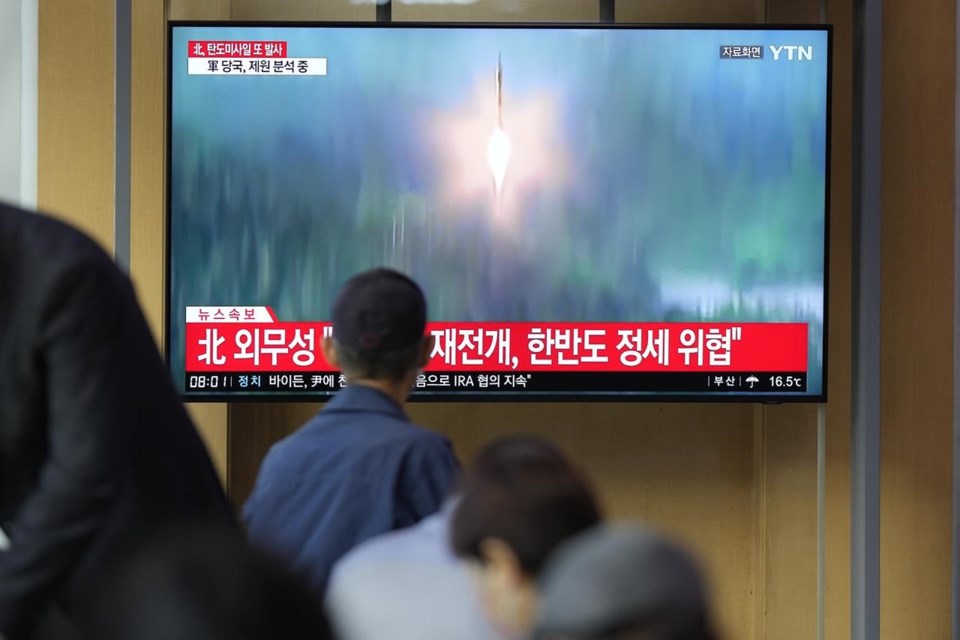SEOUL, South Korea (AP) — The nuclear-powered aircraft carrier USS Ronald Reagan launched a new round of naval drills with South Korean warships on Friday, a day after North Korea fired more ballistic missiles and flew warplanes in an escalation of tensions with its rivals.
The Reagan and its battle group returned to the waters near the Korean Peninsula after North Korea earlier this week launched a nuclear-capable missile over Japan in response to the carrier group’s earlier training with South Korean navy ships. North Korea views U.S.-South Korean military exercises as a practice to invade the country.
The latest two-day drills, which also involve U.S. and South Korean destroyers and other ships, were taking place in international waters off the peninsula’s east coast. The drills are aimed at bolstering the allies’ defense capabilities and will involve training to escort the Reagan southeast of South Korea’s southern island of Jeju, South Korea’s Joint Chiefs of Staff said in a statement.
“We will continue to strengthen our firm operational capabilities and readiness to respond to any provocations by North Korea,” the statement said.
North Korea may react to the new drills with more missile tests. The North’s Foreign Ministry said Thursday the carrier group’s redeployment poses “a serious threat to the stability of the situation on the Korean Peninsula and in its vicinity.”
Later Friday, the top nuclear envoys of South Korea, the United States and Japan had trilateral phone talks and agreed to increase their efforts to block the North’s alleged cryptocurrency thefts and other means to finance its nuclear and missile programs. The envoys also decided to solidify an international cooperation to check North Korea’s attempts to evade U.N. sanctions such as banned ship-to-ship transfers on the sea, according to South Korea's Foreign Ministry.
North Korea’s record pace of weapons testing this year is intended to expand its arsenal so that it can credibly threaten the U.S. mainland and regional allies with nuclear arms, then engage in negotiations with the U.S. from a stronger position as a recognized nuclear state. Its two ballistic missile launches on Thursday were the North’s sixth round of weapons firings in less than two weeks.
The intermediate-range North Korean missile tested Tuesday was likely a Hwasong-12 missile which is capable of reaching the U.S. Pacific territory of Guam, observers say. Other missiles launched recently are short-range weapons that target South Korea.
North Korea is ready to conduct its first nuclear test in five years and is preparing to test a new liquid-fueled intercontinental ballistic missile and a submarine-launched ballistic missile, Heo Tae-keun, South Korea’s deputy minister of national defense policy, told lawmakers earlier this week.
On Friday, Heo had trilateral video calls with his U.S. and Japanese counterparts to discuss North Korea’s recent missile tests. They stressed the security cooperation among the three countries would be bolstered if the North continues its provocations, the South Korean Defense Ministry said in a statement.
On Thursday, naval destroyers of the three countries conducted one-day joint drills off the peninsula’s east coast to hone their abilities to search, track and intercept North Korean ballistic missiles. Last week, they held anti-submarines exercises involving the Reagan in the area.
North Korea also flew 12 warplanes dozens of kilometers (miles) from the inter-Korean border, prompting the South to scramble 30 military aircraft in response. There were no clashes.
The eight North Korean fighter jets and four bombers were believed to have conducted air-to-surface firing drills, South Korea’s military said. Yonhap news agency reported it was likely North Korea’s biggest warplane mobilization for such an exercise near the border.
Hyung-jin Kim, The Associated Press



